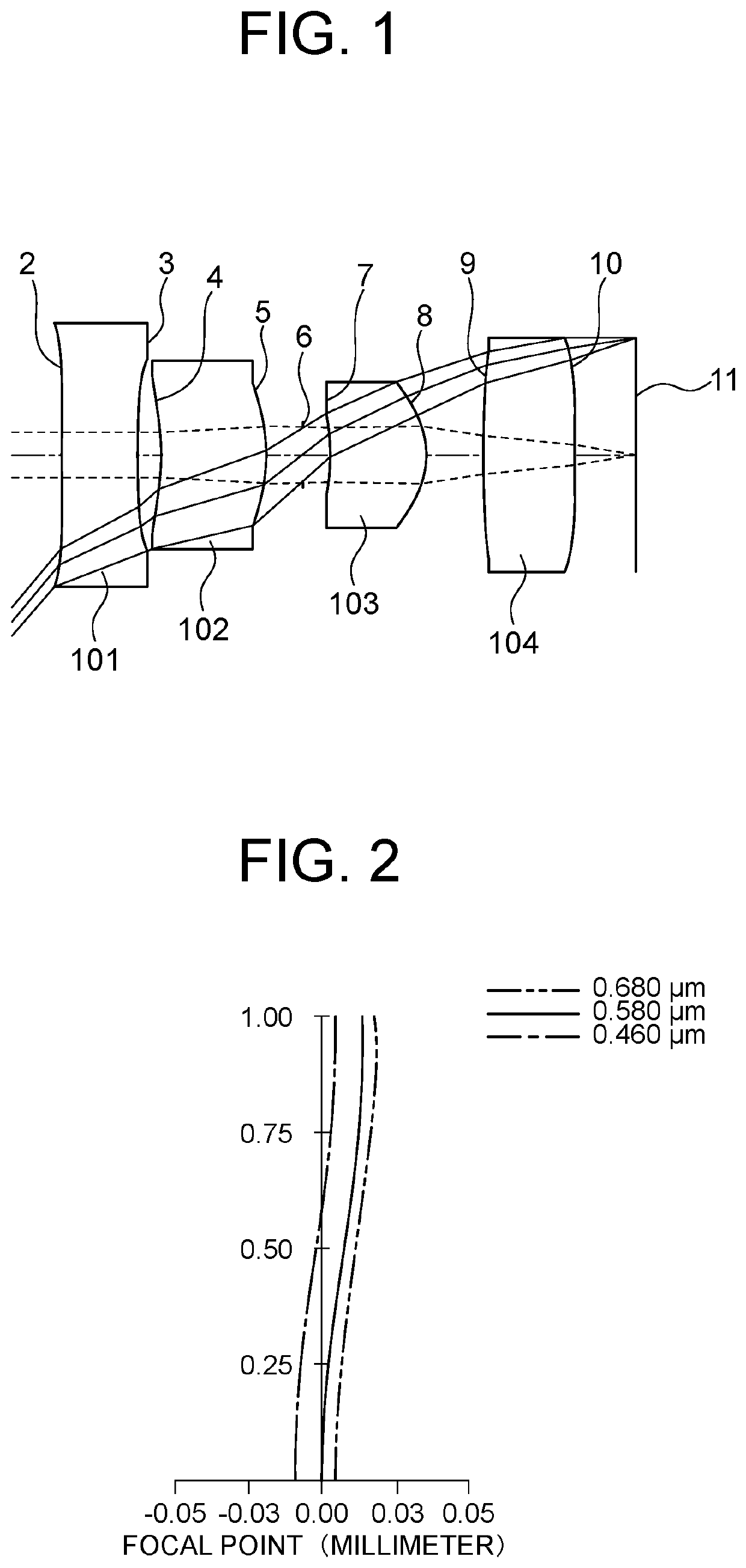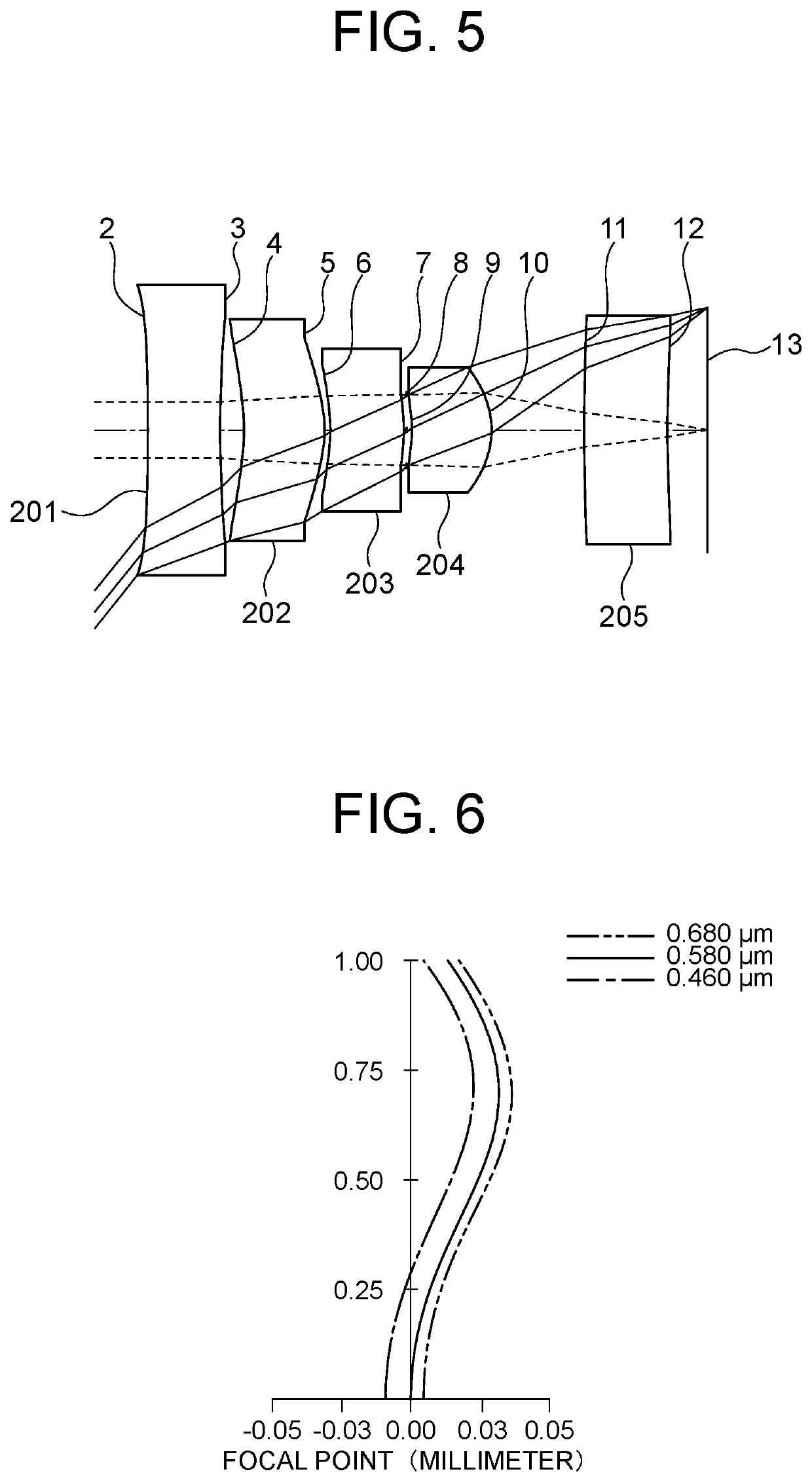Imaging optical system
a technology of optical system and optical system, applied in the field of imaging optical system, can solve the problems of insufficient aberration of compact large size and weight of wide-angle imaging optical system, and relatively difficult manufacturing process
- Summary
- Abstract
- Description
- Claims
- Application Information
AI Technical Summary
Benefits of technology
Problems solved by technology
Method used
Image
Examples
example 1
[0158]FIG. 1 shows a layout of an imaging optical system of Example 1. The imaging optical system includes four lenses arranged from the object side to the image side. Each of the first lens 101 and the fourth lens 104 is an aspheric lens in which radius of curvature of each of both surfaces is infinity in the paraxial region and which has a power in the peripheral area. Each of the second lens 102 and the third lens 103 is a positive meniscus lens which is convex toward the image. The aperture stop 6 is located between the second lens 102 and the third lens 103.
[0159]Table 1 shows positions of the optical elements and properties and values of focal length of the lenses of the imaging optical system of Example 1. The focal length f of the whole imaging optical system is given by f=0.2808. The F-number Fno is given by Fno=3.348. HFOV representing a half value of angle of view is given by HFOV=50 (degrees). In Table 1, each of the four lenses is represented respectively by lens 1 to l...
example 2
[0165]FIG. 5 shows a layout of an imaging optical system of Example 2. The imaging optical system includes five lenses arranged from the object side to the image side. Each of the first lens 201 and the fifth lens 205 is an aspheric lens in which radius of curvature of each of both surfaces is infinity in the paraxial region and which has a power in the peripheral area. Each of the second lens 202 and the fourth lens 204 is a positive meniscus lens which is convex toward the image. The third lens 203 is a negative meniscus lens which is convex toward the image. The aperture stop 8 is located between the third lens 203 and the fourth lens 204.
[0166]Table 3 shows positions of the optical elements and properties and values of focal length of the lenses of the imaging optical system of Example 2. The focal length f of the whole imaging optical system is given by f=0.264. The F-number Fno is given by Fno=2.563. HFOV representing a half value of angle of view is given by HFOV=50 (degrees)...
example 3
[0172]FIG. 9 shows a layout of an imaging optical system of Example 3. The imaging optical system includes five lenses arranged from the object side to the image side. Each of the second 302 and the fifth lens 305 is an aspheric lens in which radius of curvature of each of both surfaces is infinity in the paraxial region and which has a power in the peripheral area. The first lens 301 is a biconcave lens. The third lens 303 is a biconvex lens. The fourth lens 304 is a positive meniscus lens which is convex toward the image. The aperture stop 8 is located between the third lens 303 and the fourth lens 304.
[0173]Table 5 shows positions of the optical elements and properties and values of focal length of the lenses of the imaging optical system of Example 3. The focal length f of the whole imaging optical system is given by f=0.206. The F-number Fno is given by Fno=2.5814. HFOV representing a half value of angle of view is given by HFOV=50 (degrees). In Table 5, each of the five lenses...
PUM
 Login to View More
Login to View More Abstract
Description
Claims
Application Information
 Login to View More
Login to View More - R&D
- Intellectual Property
- Life Sciences
- Materials
- Tech Scout
- Unparalleled Data Quality
- Higher Quality Content
- 60% Fewer Hallucinations
Browse by: Latest US Patents, China's latest patents, Technical Efficacy Thesaurus, Application Domain, Technology Topic, Popular Technical Reports.
© 2025 PatSnap. All rights reserved.Legal|Privacy policy|Modern Slavery Act Transparency Statement|Sitemap|About US| Contact US: help@patsnap.com



